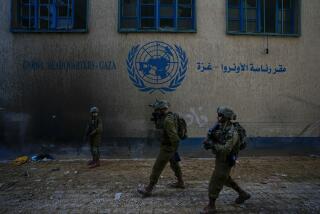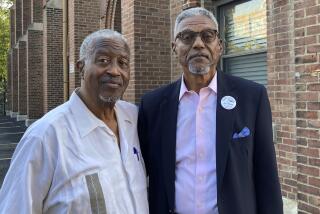Hard Claims but Only Soft Proof So Far in Iraq
WASHINGTON — After two months and more than 350 inspections, United Nations weapons teams in Iraq have so far been unable to corroborate Bush administration claims that Saddam Hussein is secretly building chemical, biological or nuclear weapons.
In particular, inspectors have found no proof of prohibited activities at a series of suspect sites -- including nuclear facilities, chemical factories and missile production plants -- that the CIA publicly identified last fall.
The U.N. inspectors, however, have also been unable to resolve scores of crucial questions about Iraq’s former weapons programs, including the location of 1.5 tons of VX nerve gas, 2 tons of anthrax growth media, 400 bombs for germ warfare agents and 550 artillery shells filled with mustard gas.
The teams have confirmed that over the last four years, Iraq illicitly obtained hundreds of missile engines without U.N. approval, as well as raw materials for rocket fuel and chemical agents. Such imports, as well as Iraq’s failure to provide an accurate account of its weapons programs, are a violation of U.N. resolutions aimed at disarming the Hussein regime, according to U.N. and U.S. officials.
That mix of results is likely to dominate Monday when Hans Blix, the chief U.N. weapons inspector, and Mohamed ElBaradei, head of the International Atomic Energy Agency, or IAEA, brief the U.N. Security Council on the first 60 days of inspections of Iraqi factories, laboratories, military facilities, presidential palaces and other sites.
Both men are expected to seek more time for inspectors to search at least 350 more sites in Iraq as well as to follow up current investigations. But they will also sharply criticize Iraq for refusing to provide new information on its past weapons programs and for refusing to allow U-2 high-altitude surveillance flights. U.N. arms teams in Iraq from 1991 to 1998 relied heavily on the American-operated spy planes for aerial reconnaissance.
Bush administration and intelligence officials insist that the failure to find illegal weapons so far simply proves that Iraq has hidden its weapons programs and arsenals in secret underground bunkers or in mobile laboratories. They say Iraq has stashed sensitive documents and other evidence in homes and farms, or under mosques and hospitals.
Such materials “are being moved constantly and hidden,” Paul D. Wolfowitz, deputy secretary of Defense, told the Council on Foreign Relations think tank in New York on Thursday. Spy satellites have photographed trucks leaving facilities while inspections were going on, other officials say.
Hussein has ordered that any scientist who cooperates in interviews “will be killed, as well as their families,” Wolfowitz said. “Furthermore, we know that scientists are being tutored on what to say to the U.N. inspectors and that Iraqi intelligence officers are posing as scientists to be interviewed by the inspectors.”
U.S. Shares Limited Data
The Bush administration, which has largely refused to release specific evidence to the public to support its claims, began sharing a limited amount of intelligence with the U.N. teams this month. Officials said they have provided specific information and tips about individuals and facilities that allegedly are part of Hussein’s illegal weapons programs, and have suggested ways to investigate them.
But inspectors in Iraq from the U.N. and the IAEA, the U.N.’s nuclear watchdog, have found little that appears to support the widely publicized U.S. assertions. To be sure, some sites are still under investigation, some results may not yet be public, and Iraq may have hidden or moved material after media reports highlighted U.S. concerns. But several of the most prominent claims appear to have been disproved.
The CIA warned in an unclassified report in October, for example, that Iraq appeared to be “reconstituting” its clandestine nuclear weapons program. As evidence, officials cited commercial satellite photos that showed new construction at Al Tuwaitha, a former nuclear weapons complex that was heavily bombed during the 1991 Persian Gulf War. Such photos, President Bush said in Cincinnati on Oct. 7, “reveal that Iraq is rebuilding facilities at sites that have been part of its nuclear program in the past.”
Experts from the IAEA have visited Al Tuwaitha 12 times since December, most recently Tuesday. They have checked equipment, sampled soil and water, conducted radiation surveys, shown up at night and on a Muslim holiday and carried out numerous other tests.
No improper activities have been found so far, according to preliminary U.N. reports. On Dec. 20, a joint U.N. and IAEA statement declared that the former Al Tuwaitha nuclear complex “now conducts civilian research in the nonnuclear field.” A British journalist who visited the site, about 15 miles south of Baghdad, reported that the new buildings “appeared to be no more than a few sheds.”
U.S. officials similarly noted seeing new buildings at the Qaim phosphates complex in western Iraq. Baghdad refined uranium ore at the facility in the 1980s in an attempt to produce fissile fuel for nuclear weapons. But the site was bombed in 1991, and other equipment later was either dismantled or destroyed by IAEA teams.
U.N. teams spent two days at Qaim in December, then returned this month by helicopter for an airborne inspection. They reported no violations, while journalists described seeing mostly rubble on a near-vacant lot.
“We have systematically followed up on not only the indications from our own satellite imagery but others provided by other countries or allegations by other countries about particular sites, including Tuwaitha,” said Mark Gwozdecky, an IAEA spokesman.
“We have followed up systematically and have not found signs of prohibited activity so far,” he said.
Iraqi Imports
Perhaps the most alarming U.S. claims last fall were about Iraq’s attempts to import tens of thousands of narrow, high-strength aluminum tubes in 2001 and 2002. Sources say Iraq used a front company in Dubai, United Arab Emirates, to try to import the tubes from China.
Such tubes can be linked in high-velocity centrifuges and “are used to enrich uranium for nuclear weapons,” Bush told the U.N. General Assembly in September. Similar assertions appeared in State Department and CIA reports.
Outside experts quickly raised doubts, however, noting that Iraq had imported thousands of similar tubes from Italy in the 1980s for helicopter-launched air-to-ground rockets. Extensive retooling would be needed to use the tubes to enrich uranium, officials said. Iraq claims that the new tubes were meant for short-range 81-millimeter rockets.
Investigation Continues
On Jan. 9, ElBaradei told reporters that the case was still under investigation.
“But we believe at this stage that these aluminum tubes were intended for the manufacturing of rockets,” he said.
In another case, the CIA warned last fall that Baghdad had rebuilt and expanded factories that also could produce chemical weapons. The “best examples,” it said, were the chlorine and phenol production plants at Fallujah II, which was bombed in 1991.
Although both chemicals have civilian uses, they are also raw materials for the synthesis of precursor chemicals used to produce blister and nerve agents.
“Iraq is seeking to purchase [chemical weapon] agent precursors and applicable production equipment and is trying to hide the activities of the Fallujah plant,” the CIA said.
U.N. chemical teams have visited Fallujah II, about 40 miles northwest of Baghdad, four times since December. They checked “all key buildings” and accounted for equipment previously inspected and marked by U.N. teams in the 1990s.
“The chlorine plant is currently inoperative,” the U.N. team reported Jan. 17.
The CIA also warned last fall that “key aspects of Iraq’s offensive [biological weapons] program are active and most elements are more advanced and larger” than before the Gulf War.
As evidence, it said Iraq had begun renovating or constructing facilities at several sites secretly used to produce biological agents for germ warfare in the 1980s, including the Al Dawrah Foot-and-Mouth Disease Vaccine Facility, the Amiriyah Serum and Vaccine Institute, and the Fallujah III Castor Oil Production Plant.
U.N. inspectors have now visited all three sites several times. They searched warehouses, refrigerators, trucks and laboratories, checked equipment, and took soil and water samples. Some of the buildings were abandoned shells, while others had limited operations. No evidence was found that Iraq is using the facilities to produce microbes for banned weapons.
U.S. officials say overwhelming evidence indicates that Iraq is planning to resume building ballistic missiles able to deliver warheads farther than 90 miles, the limit set by the U.N. Security Council after the Gulf War.
As evidence, they say Iraq has built a large new testing stand at Al Rafah North, Baghdad’s principal site for testing liquid propellant missile engines. The stand “is clearly intended for testing prohibited longer-range missile engines,” the White House said in a background paper for Bush’s Sept. 12 speech to the General Assembly.
U.N. teams visited Al-Rafah on Nov. 27, their first day of inspections in Iraq. Monitoring equipment installed by U.N. teams in the 1990s had been improperly removed, they found. No other prohibited activity was reported. They returned Jan. 9 to witness the static test-firing of a short-range missile engine allowed under U.N. resolutions.
Baghdad has also rebuilt and expanded the Al Mutasim Solid Rocket Motor and Test Facility, according to U.S. intelligence. The “size of certain facilities there,” the CIA wrote in October, suggests that Baghdad is “preparing to develop” prohibited missile systems.
U.N. inspectors have made five visits to Al Mutasim, however, and reported no violations. They also reported no evidence of illegal activity at Al Mamoun, where the CIA said the “only logical explanation” for recent construction is that Iraq plans to develop prohibited long-range missiles. U.N. reports made public so far do not say whether new equipment or facilities at the three sites could also be used to build or test long-range missiles, as U.S. officials contend.
Administration officials have not backed down from their claims about Iraqi weapons programs or from their insistence that Iraq is simply concealing illegal weapons activities from the U.N. teams.
But in response to a question, Wolfowitz -- one of the administration’s most prominent hawks on Iraq -- acknowledged Thursday that at least some of the White House assertions should now be reevaluated.
“Yeah, it’s possible that we have been misinformed on some things,” he said.
*
Drogin reported from Washington and Farley from the United Nations.
*
(BEGIN TEXT OF INFOBOX)
War of words on Iraq
“I don’t think it is up to us. We are doing all things we think can prevent war.... We have been doing everything we’ve been asked to do, and we got nowhere.”
Gen. Amir Saadi, Iraqi President Saddam Hussein’s chief advisor on U.N. weapons inspections
“We are doing this deliberately, wholeheartedly, patiently, but there will be ultimately an end, I believe, to the patience of the international community, and we’re doing it in full consultation and coordination with our friends and allies, some of whom have a different perspective on it than we do.”
Secretary of State Colin L. Powell
“The administration is not going to be deterred by the U.N. report, European crankiness, antiwar sentiment at home or regional efforts by Saddam’s neighbors to get him to comply. It won’t be swayed, although it may allow a bit more time for the inevitable to unfold. President Bush may not have issued a formal order yet, but he has made up his mind.”
Judith Yaphe, a former CIA analyst now at the National Defense University in Washington
- Los Angeles Times
More to Read
Sign up for Essential California
The most important California stories and recommendations in your inbox every morning.
You may occasionally receive promotional content from the Los Angeles Times.











